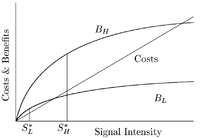- Handicap principle
-
The handicap principle is a hypothesis originally proposed in 1975 by biologist Amotz Zahavi[1][2][3] to explain how evolution may lead to "honest" or reliable signaling between animals who have an obvious motivation to bluff or deceive each other. The handicap principle suggests that reliable signals must be costly to the signaler, costing the signaler something that could not be afforded by an individual with less of a particular trait. For example, in the case of sexual selection, the theory suggests that animals of greater biological fitness signal this status through handicapping behaviour or morphology that effectively lowers this quality. The central idea is that sexually selected traits function like conspicuous consumption, signalling the ability to afford to squander a resource simply by squandering it. Receivers know that the signal indicates quality because inferior quality signallers cannot afford to produce such wastefully extravagant signals.
The generality of the phenomenon is the matter of some debate and disagreement, and Zahavi's views on the scope and importance of handicaps in biology remain outside the mainstream.[4] Nevertheless, the idea has been very influential,[5][6][7] with most researchers in the field believing that the theory explains some aspects of animal communication.
Contents
Handicap models
 Johnstone's 1997[5] graphical representation of a Zahavian handicap. Where CL is cost to a low-quality signaller and CH is cost to a high-quality signaller. Optimal signalling levels are
Johnstone's 1997[5] graphical representation of a Zahavian handicap. Where CL is cost to a low-quality signaller and CH is cost to a high-quality signaller. Optimal signalling levels are
 for a low-quality signaller, and
for a low-quality signaller, and  for a high-quality signaller.
for a high-quality signaller.Though the idea was initially controversial[8][9][10][11] (John Maynard Smith being one notable early critic of Zahavi's ideas[12][13][14]) it has gained wider acceptance due to supporting game theoretic models, most notably Alan Grafen's signalling game model.[15] Grafen's model is essentially a rediscovery of Michael Spence's job market signalling model,[16] where the signalled trait was conceived as a courting male's quality, signalled by investment in an extravagant trait -such as the peacock's tail- rather than an employee signalling their quality by way of a costly education. In both cases, it is the decreased cost to higher-quality signallers of producing increased signal that stabilizes the reliability of the signal (Fig. 2).
A series of papers by Getty[17][18][19][20] shows that Grafen’s proof of the handicap principle depends on the critical simplifying assumption that signalers trade off costs for benefits in an additive fashion, the way humans invest money to increase income in the same currency. This is illustrated in the figures to the right, from Johnstone 1997.[5] This assumption that costs and benefits trade off in an additive fashion is contested to be valid for the survival cost – reproduction benefit trade-off that is assumed to mediate the evolution of sexually selected signals. It can be reasoned that as fitness depends on the production of offspring, this is therefore a multiplicative function of reproductive success.[21]
Further formal game theoretical signalling models demonstrated the evolutionary stability of handicapped signals in nestlings' begging calls,[22] in predator-deterrent signals[23] and in threat-displays.[24][25] In the classic handicapped models of begging, all players are assumed to pay the same amount to produce a signal of a given level of intensity, but differ in the relative value of eliciting the desired response (donation) from the receiver (Fig. 3).
 Johnstone's 1997[5] graphical representation of a handicapped signal of need. Where BL and BH are the benefits to Low and High motivated signallers. Optimal signalling levels are
Johnstone's 1997[5] graphical representation of a handicapped signal of need. Where BL and BH are the benefits to Low and High motivated signallers. Optimal signalling levels are
 for a low-motivation signaller, and
for a low-motivation signaller, and  for a high-motivation signaller.
for a high-motivation signaller.Counter-examples to handicap models predate handicap models themselves. Models of signals (such as threat displays) without any handicapping costs show that conventional signalling may be evolutionarily stable in biological communication.[26] Further, analysis of some begging models also shows that, in addition to the handicapped outcomes, non-communication strategies are not only evolutionarily stable, but lead to higher payoffs for both players.[27][28]
Generality and empirical examples
The theory predicts that a sexual ornament, or any other signal, must be costly if it is to accurately advertise a trait of relevance to an individual with conflicting interests. Typical examples of handicapped signals include bird songs, the peacock's tail, courtship dances, bowerbird's bowers, or even possibly jewellery and humor. Jared Diamond has proposed that certain risky human behaviours, such as bungee jumping, may be expressions of instincts that have evolved through the operation of the handicap principle. Zahavi has invoked the potlatch ceremony as a human example of the handicap principle in action. This interpretation of potlatch can be traced to Thorstein Veblen's use of the ceremony in his book Theory of the Leisure Class as an example of "conspicuous consumption".[29]
The handicap principle gains further support by providing interpretations for behaviours that fit into a single unifying gene-centered view of evolution and making earlier explanations based on group selection obsolete. A classic example is that of stotting in gazelles. This behaviour consists in the gazelle initially running slowly and jumping high when threatened by a predator such as a lion or cheetah. The explanation based on group selection was that such behaviour might be adapted to alerting other gazelle to a cheetah's presence or might be part of a collective behaviour pattern of the group of gazelle to confuse the cheetah. Instead, Zahavi proposed that each gazelle was communicating to the cheetah that it was a fitter individual than its fellows and that the predator should avoid chasing it.
Immunocompetence handicaps
The theory of immunocompetence handicaps suggests that androgen-mediated traits accurately signal condition due to the immunosuppressive effects of androgens.[30] This immunosuppression may be either because testosterone alters the allocation of limited resources between the development of ornamental traits and other tissues, including the immune system,[31] or because heightened immune system activity has a propensity to launch autoimmune attacks against gametes, such that suppression of the immune system enhances fertility.[32] Healthy individuals can afford to suppress their immune system by raising their testosterone levels, which also augments secondary sexual traits and displays. A review of empirical studies into the various aspects of this theory found weak support.[33]
Examples
Directed at members of the same species
Amotz Zahavi studied in particular the Arabian Babbler, a very social bird, with a life-length of 30 years, which was considered to have altruist behaviours. The helping-at-the-nest behavior often occurs among unrelated individuals, and therefore cannot be explained by kin selection. Zahavi reinterpreted these behaviours according to his signal theory and its correlative, the handicap principle. The altruistic act is costly to the donor, but may improve its attractiveness to potential mates. The evolution of this condition may be explained by competitive altruism.
The tail of a peacock makes the peacock more vulnerable to predators, and is therefore a handicap. However, the message that the tail carries to the potential mate peahen may be 'I have survived in spite of this huge tail; hence I am fitter and more attractive than others'.
An example in humans was suggested by Geoffrey Miller who expressed that Veblen goods such as luxury cars and other forms of conspicuous consumption are manifestations of the handicap principle, being used by men to advertise their "fitness" to women. Obesity, a sign of ability to procure or afford plenty of food, comes at the expense of health, agility, and in more advanced cases, even strength, but, before recent cultural changes, exhibited "fitness" to the opposite sex and was also often associated with wealth. On the opposite end of the spectrum, significantly above average height, stoutness, and lean body mass require vastly higher caloric intake and come at the expense of speed, more than can be offset by the defensive advantages, but are highly attractive to females. Modern bodybuilding with steroids is an especially notable example, where bodybuilders are willing to knowingly forfeit general health to high risk of injury and the immunosuppressant qualities of excess androgens, risk impotence, and grow to sizes that are inconvenient and impractical in the modern world, in exchange for the appearance of supreme physical health and reproductive fitness.
Directed at other species
The signal receiver need not be a conspecific of the sender, however. Signals may also be directed at predators, with the function of showing that pursuit will probably be unprofitable. Stotting, for instance, is a sort of hopping that certain gazelles do when they sight a predator. As this behavior gives no evident benefit and would seem to waste resources (diminishing the gazelle's head start if chased by the predator), it was a puzzle until handicap theory offered an explanation. According to this analysis, if the gazelle simply invests a bit of energy to show the predator that it has the fitness necessary to avoid capture, it may avoid having to evade the lion in an actual pursuit. The lion, faced with the demonstration of fitness, might decide that it might not catch this gazelle, and thus, avoid a wasted pursuit. The benefit to the gazelle is twofold. First, for the small amount of energy invested in the stotting, the gazelle might not have to expend the tremendous energy required to evade the lion. Second, if the lion is in fact capable of catching this gazelle, the gazelle's bluff leads to its survival that day.
Another example is provided by larks, some of which discourage merlin by sending a similar message: they sing while being chased, telling their predator that they will be difficult to capture.[34]
See also
References
- ^ Zahavi, A. (1975) Mate selection - a selection for a handicap. Journal of Theoretical Biology 53: 205-214.
- ^ Zahavi, A. (1977) The cost of honesty (Further remarks on the handicap principle). Journal of Theoretical Biology 67: 603-605.
- ^ Zahavi, A. and Zahavi, A. (1997) The handicap principle: a missing piece of Darwin's puzzle. Oxford University Press. Oxford. ISBN 0-19-510035-2
- ^ Review by Andrew Pomiankowski, A. & Iwasa, Y. 1998. Handicap Signaling: Loud and True? Evolution, 52, 928-932
- ^ a b c d Johnstone, R.A. (1995) Sexual selection, honest advertisement and the handicap principle: reviewing the evidence" Biological Reviews 70 1-65.
- ^ Johnstone, R.A. (1997) The evolution of animal signals, In Behavioural Ecology: an evolutionary approach 4th ed., J. R. Krebs and N. B. Davies, editors. Blackwell. Oxford, pp:155-178.
- ^ Maynard Smith, J. and Harper, D. (2003) Animal Signals. Oxford University Press. ISBN 0-19-852685-7.
- ^ Davis, J. W. F., & O’Donald, P. (1976). Sexual selection for a handicap: A critical analysis of Zahavi’s model. Journal of Theoretical Biology, 57, 345–354.
- ^ Eshel, I. (1978). On the handicap principle — a critical defence. Journal of Theoretical Biology, 70, 245–250
- ^ Kirkpatrick, M (1986) The handicap mechanism of sexual selection does not work. American Naturalist 127:222-240.
- ^ Pomiankowski, A. (1987). Sexual selection: The handicap principle does work sometimes. Proc. R. Soc. Lond., Series B, 231, 123–145.
- ^ Maynard Smith, J. (1976). Sexual selection and the handicap principle. Journal of Theoretical Biology, 57, 239–242
- ^ Maynard Smith, J. (1978). The handicap principle — a comment. Journal of Theoretical Biology,70, 251–252
- ^ Maynard Smith, J. (1985). Mini review: Sexual selection, handicaps and true fitness. Journal of Theoretical Biology, 115, 1–8.
- ^ Grafen, A. (1990) Biological signals as handicaps. Journal of Theoretical Biology 144:517-546.
- ^ Spence, A.M. (1973) Job Market Signaling. Quarterly Journal of Economics 87:355-374.
- ^ Getty, T. (1998) Handicap signalling: when fecundity and viability do not add up. Anim. Behav. 56, 127–130
- ^ Getty, T. (1998) Reliable signalling need not be a handicap. Anim. Behav. 56, 253–255
- ^ Getty, T. (2002) Signaling health versus parasites. Am. Nat. 159,363–371
- ^ Getty. T (2006) Sexually selected signals are not similar to sports handicaps. Trends Ecol. & Evol 21, 83-88
- ^ Nur, N. and Hasson, O. (1984) Phenotypic plasticity and the handicap principle. J. Theor. Biol. 110, 275–297
- ^ Godfray, H.C.J. 1991. Signalling of need by offspring to their parents, Nature 352 328-330.
- ^ Yachi, S. 1995. How can honest signalling evolve? The role of the handicap principle. Proceedings of the Royal Society of London, series B 262 283-288.
- ^ Adams, E.S. & Mesterton-Gibbons, M. 1995. The cost of threat displays and the stability of deceptive communication. Journal of Theoretical Biology 175 405-421.
- ^ Kim, Y-G. 1995. Status signalling games in animal contests. Journal of Theoretical Biology 176, 221-231.
- ^ Enquist, M. 1985. Communication during aggressive interactions with particular reference to variation in choice of behaviour. Animal Behaviour 33 1152-1161.
- ^ Rodriguez-Girones, M.A., Cotton, P.A. & Kacelnik, A. 1996. The evolution of begging: signaling and sibling competition. Proceedings of the National Academy of Sciences USA, 93:14637-14641.
- ^ Lachmann, M. & Bergstrom, C.T. 1998. Signalling among relatives. II. Beyond the tower of babel. Theoretical Population Biology, 54:146-160.
- ^ Bliege Bird, R. and Smith, E. A. (2005). Signalling theory, strategic interaction, and symbolic capital. Current Anthropology, 46(2), 221-248.
- ^ Folstad, I. & Karter, A.K. (1992) Parasites, bright males, and the immunocompetence handicap. American Naturalist 139:603-622.
- ^ Wedekind, C. and Folstad, I. (1994) Adaptive or non-adaptive immunosuppression by sex hormones? American Naturalist 143:936-38.
- ^ Folstad, I. & Skarstein, F. (1996) Is male germ line control creating avenues for female choice? Behavioral Ecology 8:109-112
- ^ Roberts, M.L., Buchanan K.L., Evans, M.R. (2004). Testing the immunocompetence handicap hypothesis: a review of the evidence. Animal Behaviour. 68:227-239
- ^ For footage of this, see Attenborough, D. (1990) The Trials of Life, Episode 10. BBC.
External links
Categories:
Wikimedia Foundation. 2010.



